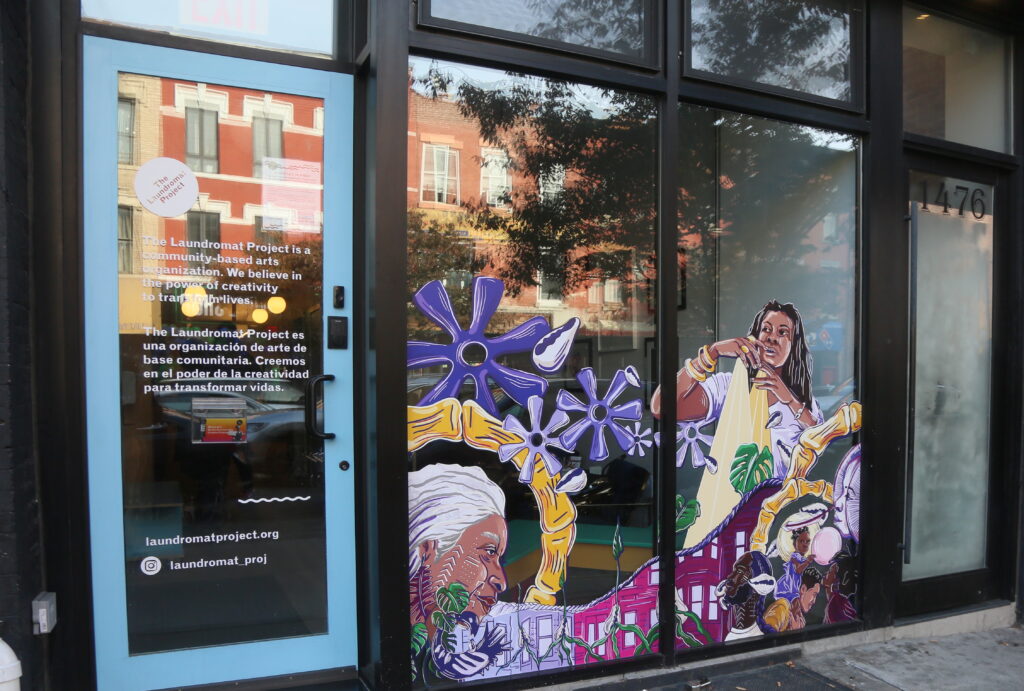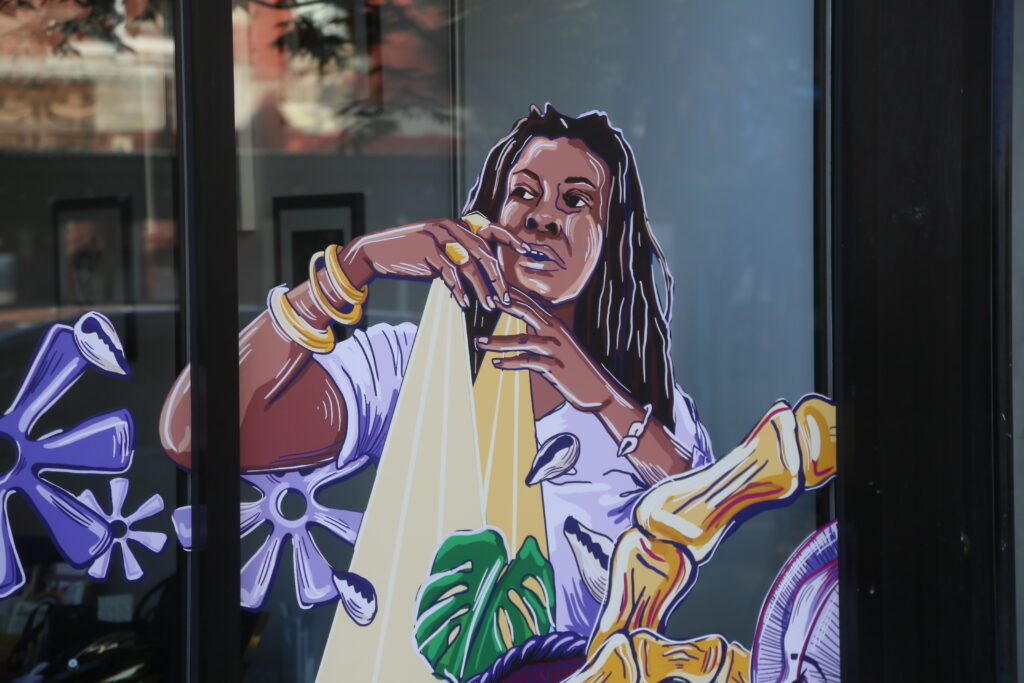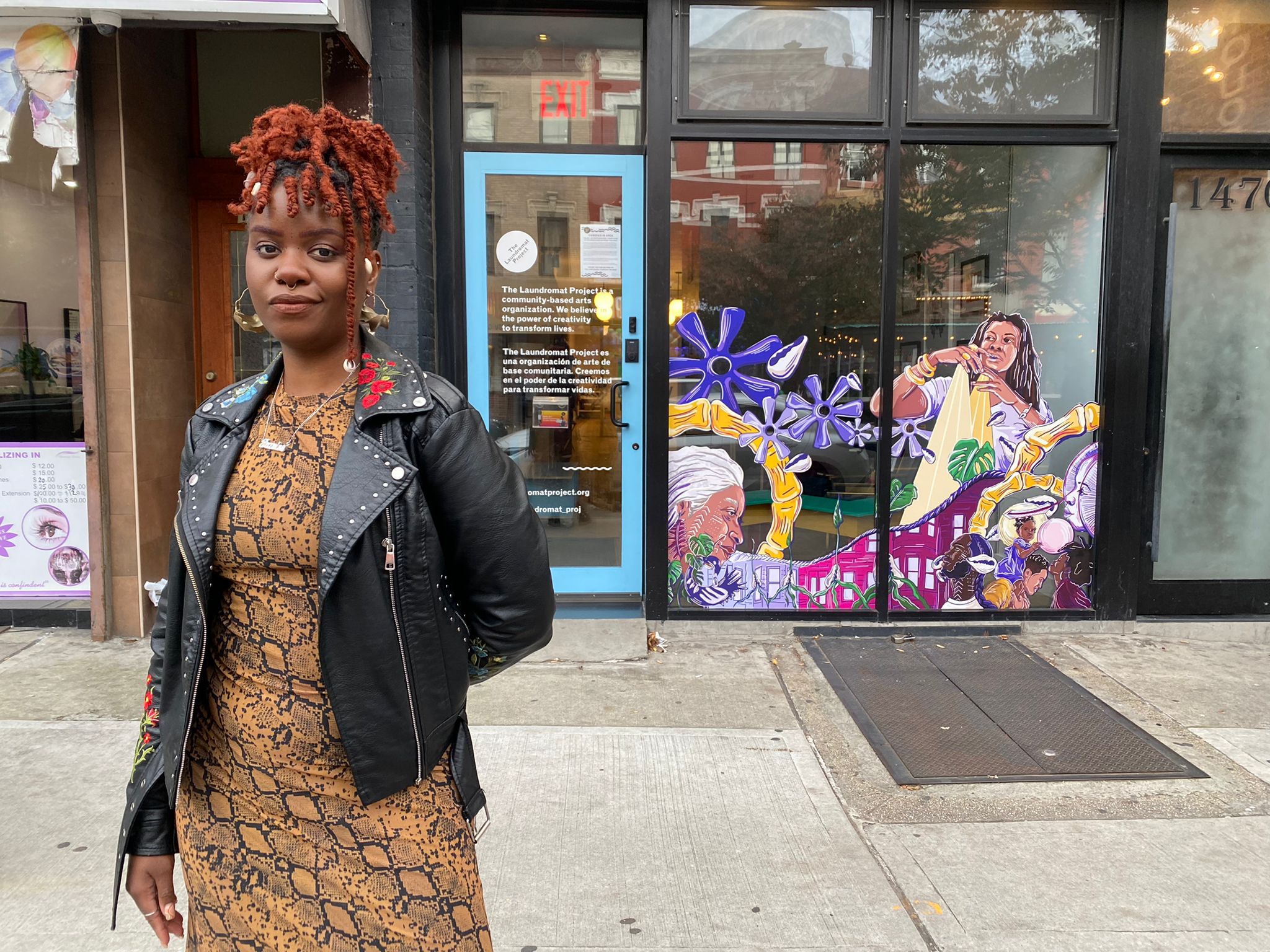The Laundromat Project’s Fulton Street Window Commission, now in its second year, invites a Bed-Stuy visual artist to design artwork for a one-year vinyl installation on the main window of our community hub space.
This year, we selected Jazmine Hayes’ work to be displayed at our storefront’s window, and we are excited to share her work with our neighbors and community members! Read on to learn more about Jazmine and her work, “Through Our Hands We Are Guided”, which you can see in-person at The Laundromat Project’s storefront at 1476 Fulton Street in Brooklyn through 2023.
Tell us about yourself and your art practice.
My name is Jazmine Hayes. I’m originally from East New York but grew up very deeply in Bed-Stuy. I’ve been creating art all of my life, whether it was music or visual art. I think as I get older, my art—or whatever I do creatively—feels more and more like a prayer, whether it’s a prayer to my community, a prayer for myself, or a prayer to my ancestors. I work in a range of mediums. I’ve been doing murals for over 11 years working with nonprofit youth arts organizations across New York City.
What is the artwork called?
This piece is titled Through Our Hands We Are Guided.

Can you talk a little bit about the hands depicted in the piece?
There are two times I see hands: the hands of the baby and the hands of the woman. So the two times you see hands, they’re actually an intergenerational interaction, right? Thinking of the elders in the community who have built this community, any craftsman, craftsmanship, or crafts work is done with your hands right down to being anointed in church, down to cooking a meal for someone… that’s all a craft done with your hands. We create with our hands, and I think that is a physical manifestation of a prayer. And so Through Our Hands We Are Guided.
Can you tell us a little more about the symbolism in the piece?
A lot of this mural is about gentrification’s effect on Bed-Stuy, and how our culture and our history are still so prevalent, strong, and founded in care and passion. Thinking about how we are rooted in care and love…we’re molded. And so how do we shapeshift wherever we move in the world? How do we shapeshift in our community as it’s changing? That’s why we have the cowrie shells, a divination of where we are being guided to, whether we’re staying in Bed-Stuy or moving out.
The door knocker is like an ode to the hood girl. Beauty supply stores are like our Mecca, the secret of our fashion. So when I think of door knockers, I think about all the jewelry shops down on Fulton Street. Whether you’re going to get your nameplate necklaces, your door knockers, or your fulani earrings—you can also go to the beauty supply store if you can’t afford the jewelry shops. We’ve been shamed and shunned for our hairstyles, our fashion, our long nails, and our earrings. So using the door knockers as halos is kind of like the hood girls are angels, you know, they are the protectors.
The anansi is a symbol of wisdom, but I’m also thinking of the spider. Spiders have eight legs, and eight is a number of abundance. A number of breaking cycles. And thinking on cycles, there’s also a Sankofa bird that represents the past, present, and future. How are we passing down these things to the next generation? What are we taking from the generations before us? How are we present in this moment and what’s happening to Bed-Stuy? Gentrification is hitting us hard, but there’s still such a beautiful community that is not giving up, which I love.
The braids are also like an intergenerational thing, like weaving in our stories and an ode to our culture. You have the young man with the braids in his hair. I wanted to represent that that’s not just something for Black femmes, but it’s also for Black men as well. The patterning on the faces represents mud cloth, thinking of different African patterns or almost like a Pan-African reference to the community.
You have the cowrie shells, the long braid with the brownstones underneath the door knockers, anansi, the Sankofa bird… Where do we go next? Where do we stay? How? How are we founded and grounded?
Anything else?
The Black family. You have so many people who have migrated from the South, who have migrated from the Caribbean, and we all meet in this community, and we’re just all one family. You know, these are different aspects of healing, different aspects of prayer, and I wanted to represent that in this piece.

What do healing and wellness look like to you?
Plant life is healing. I think what’s beautiful about Bed-Stuy is that you can walk past the stoops in the summertime or certain gardens and you just see plants flourishing. You see the monstera plants, the taro plants, sunflowers, and all the trees, etc. Sometimes that’s the most nature we get in such a concrete city. Wellness is about your spirit and how you treat others. What’s your relationship with yourself? I think most times our relationship with self, it’s always going to affect how we treat others. And when you have a good relationship with yourself, you treat others with that same respect.
What do you hope that people take away from this piece?
I like to have little secrets and symbols in the piece. So I like for people to walk past it and be like, “Oh, wait, I didn’t notice this part of the piece the other day.” I wanted to speak to them in those ways where it causes them to stop and just be present in that moment. Do you see yourself in this piece? Do you relate to it in any way? Most of all, I want people to take away joy from the piece. It can be a part of their daily walk, and like, “Oh, I’m excited to see this piece when I’m walking by The Laundromat Project on Fulton Street.”
What do you love about Bed-Stuy?
What I love about Bed-Stuy are the people and the resources. You have Restoration Plaza, you have the spiritual shops, you got the herbal shops. I’m half Trini, so I love doubles! I really love the community and the mom-and-pop shops. I love all of that still exists in Bed-Stuy, even as new businesses are opening. They also still have a very homely feel like they’ve been here for a long time.
What do you enjoy about making art?
Telling stories. I enjoy telling stories in my artwork. I enjoy talking to different people. I enjoy hearing other stories. My artwork allows me to explore histories I didn’t know. So all of my projects are very research-based. When you start to ask more questions, you start to find out so much more. I enjoy that process a lot in my practice and in artwork in general.
What do you hope to achieve through this project in the long run?
I would like for this to grow with The Laundromat Project as an archival project of voice recordings of different people who have lived in Bed-Stuy for a long period of time–Black-owned businesses, old and new, etc… It’s really a historical project for me, documenting our history because our histories often aren’t. I would like people to take away from this artwork that I don’t know where you come from, but I know where you’re going. Honor yourself. Honor your truth. So if you’re from Bed-Stuy–honor that, take that wherever you go. I’m from East New York and Bed-Stuy. So I take that wherever I go. Honor your truth.
This interview has been edited for length and clarity.
Jazmine Hayes is an interdisciplinary artist born, raised and based in Brooklyn, New York. She received an MFA from CUNY Hunter College and a BFA from CUNY Queens College. Her practice explores histories of the African diaspora and the ways they are preserved and reproduced through cultural traditions. Through this exploration, Hayes works across an array of mediums such as installation, painting, drawing, performance, video, sound, textile and writing. Hayes has been featured in Art Forum, Interview Magazine, Artnet, and several other publications. For over 10 years, she has worked with community-based youth organizations across New York City as an educator and muralist with non-profits such as Groundswell Mural, Artistic Noise, and Made in Brownsville. She believes in the accessibility of art resources for the development of Black and Brown youth. She has recently been awarded a U.S. Fulbright for the year of 2022-2023 to travel abroad to Senegal.
